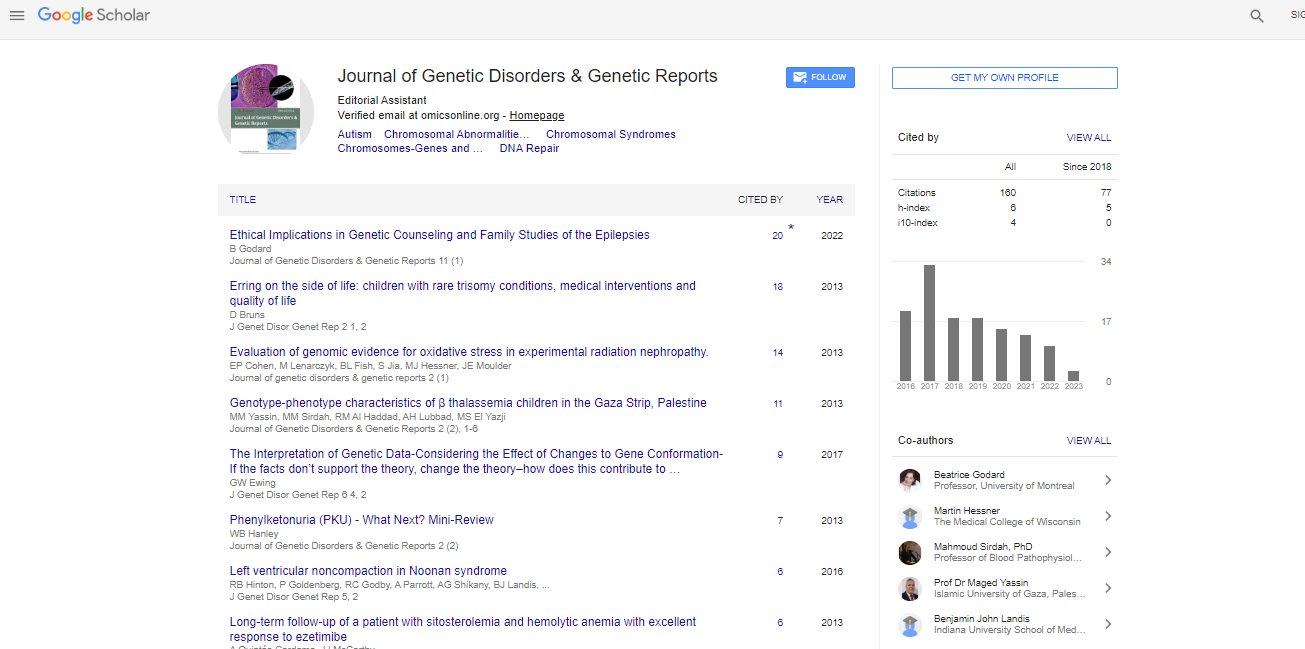Editorial, J Genet Disor Genet Rep Vol: 10 Issue: 7
Evolutionary Genetic Information
Malika Qureshi
* Department of Genetics, Pakistan Jordan Medical College, Pakistan
*Corresponding author: Arman Q, Department of Genetics, Pakistan Metropolitan Geriatric Medical College, Pakistan; E-mail: Malika676@gmail.com
Received date: July 05, 2021; Accepted date: July 20, 2021; Published date: July 29, 2021
Keywords: Evolution , Y -chromosome, zygote
Introduction
The first major contribution of theoretical population genetics to the understanding of natural variation arose from the invention that Mendelian inheritance could underlie apparently continuous traits. RA Fisher published a paper demonstrating how the phenotypic variation in a trait, and correlations between relatives, could be used to partition variation into genetic and environmental components, and also how the genetic component might be further partitioned into terms representing additive, dominant and epistatic contributions across loci.
This finding, along side earlier work on quantitative theories of inbreeding, had two important consequences. First, it naturally gave rise to a way for estimating the genetic contribution to variation for any quantitative trait. Second, it provided a means of predicting the effect of any artificial selection regime, as practiced by agriculturalists – and of course a framework within which to develop more efficient methods of breeding crops and animals with more desirable qualities and quantities. To understand the influence of those evolutionary factors, one must first be ready to describe and quantify the quantity of genetic variation during a population and therefore the pattern of genetic variation among populations. In recent years, new laboratory techniques have made it possible to get molecular genetic data in any species, and variety of software packages became available to estimate the important parameters in population genetics and related topics. In addition, the online Evolution Directory is a source of information about different molecular techniques, estimation procedures, and other current evolutionary genetic information. genes on the Y - chromosome pass directly from fathers to sons, avoiding all female intermediaries. In particular the Y -chromosome reproduces itself during a haploid instead of diploid manner, by cloning itself from generation to generation.
There is also important genetic material in mitochondria, which are organelles that are carried inside cells but outside the nucleus . In humans and most animals, these are cloned from the mother. Such extranuclear loci would then be carried from mothers to daughters in a haploid manner. Higher plants even have chloroplasts, which are another sort of extranuclear organelle that are passed maternally. In unitary populations, each organism is resulting from a zygote whose growth is determinate and predictable. These individuals are often distinguished as single unit like dogs, cats, spiders, insects, fish, birds and amphibians. However, just in case of modular population, an organism develops from a zygote and is a unit module from which several other modules are produced, forming a branching pattern such as plants, sponges, hydroids, fungi, bacteria and corals. The structure and pattern of modular organisms is indeterminate and unpredictable. Many plants, grasses and perennial herbaceous plants grow root extensions to make new shoots or suckers which will remain attached to root extensions or break off to measure independently. These new individuals grow and canopy a substantial larger area but appear to be a private . The individual tree or plant produced by amphimixis and thus arising from a zygote may be a genetic individual or genet but modules produced asexually by the genet are ramets. In a grass or weeds, variety of young plants arise through runners or stolons, once they break away the parent form new plants. These groups of new plant are called as ramets. The ramets either remains attached to the parent genet or they'll separate and grows independently into new individual. Individuals of ramets are genetically same and replica of parent plant Small population size is also important when a population grows from a few founder individuals, a phenomenon termed founder effect. For example, many island populations appear to possess started from a really small number of founders.
If a single female who was fertilized by a single male founds a population, then only four genomes, two from the female and two from the male, may start a new population. In plants, an entire population may be initiated from a single seed The dispute between the two possibilities outlined in talk lasted many years. Much effort was expended trying to work out whether electrophoretic variants were nearly neutral or maintained by balancing selection, either by fitting theoretical models or by using tests supported allele frequency changes in experimental populations. Despite some success for individual cases, especially with the very sensitive fitness measures that would be obtained with bacterial chemo state, it became evident that the majority electrophoretic variants were probably too weakly selected for selection to be detectable by direct experimentation, although repeatable clinical patterns in allele frequencies suggested the action of selection in some cases perhaps more forcefully than tactfully, attempts to discriminate between neutrality and selection as general explanations for the patterns revealed by electrophoresis were largely inconclusive The human microbiome comprises bacteria, archaea, viruses, and microbial eukaryotes living in our bodies. The taxonomic composition of those communities has been extensively studied and is significantly related to a spread of diseases and traits. However, each species within the microbiome is genetically heterogeneous, comprising individual cells whose genomes contain different mutations.
 Spanish
Spanish  Chinese
Chinese  Russian
Russian  German
German  French
French  Japanese
Japanese  Portuguese
Portuguese  Hindi
Hindi 



